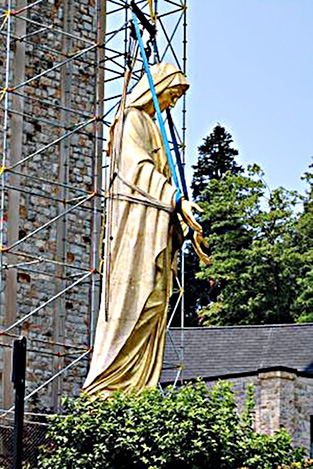
Richard D. L. Fulton
The iconic gold-gilded statue of the Virgin Mary has finally returned to the National Shrine Grotto of Our Lady of Lourdes, after having been removed to address the statue’s interior structural steel supports, which had become corroded over time and needed to be significantly refurbished.
The corrosion was discovered by university officials during the summer of 2021 when the Mount was preparing to have the statue re-gilded, according to a Mount press release. Now that the statue has been returned, work can resume to reapply the gold gilding.
Before the corrosion issues had been discovered, Gerry Jackson, writing for the Catholic Review, noted in “Emmitsburg grotto awaits return of statue of Blessed Virgin Mary,” that the Grotto “was able to raise $200,000 to replace the gold-leaf gilding.” Jackson credited Mount Saint Mary’s University President Timothy Trainor. In 2021, during an annual May crowning ceremony, Trainor pointed out that the statue was in need of a touch-up and started the campaign to raise the initial $200,000 for re-gilding.
ADTEK Engineers Inc., a structural engineering firm located in Frederick, and Big Hook Crane and Rigging, a Union Bridge company, were contracted to work on the project, commencing with the removal of the statue by Big Hook, who lowered the statue onto a trailer and secured it for transport to storage, pending the restoration work.
Upon the removal of the statue, Mount Saint Mary’s University President Timothy Trainor stated, “The Blessed Mother has watched over (the) campus with her motherly heart and offered hope to millions… Now it is our turn to care for her image and ensure that her beacon of faith and hope shines for future generations.”
Dawn Walsh, director of the National Shrine Grotto, said, “May Our Lady long continue to fulfill this holy purpose,” adding, “While the Blessed Mother statue is away from the mountain, we will continue to welcome many thousands a year as a place of worship, pilgrimage, conversion, and reconciliation.”
Regarding the absence of the statue as it awaited to be refurbished, Walsh told the Catholic Review, “It’s lonely up here,” joked Dawn Walsh, director of the National Shrine Grotto. “Not seeing Our Lady up on that hill is just a little strange,” adding that the upside is “knowing that she will be up there for at least the next 100 years once these restorations are complete.”
For more than five decades, the iconic 26-foot statue of Mary has overlooked the Grotto and the campus of Mount Saint Mary’s University from atop the 78-foot Pangborn Memorial Campanile (Italian-style bell tower) upon which she stands. “Pangborn” relates to the fact that the statue was donated by the Pangborn Foundation and its chairman, Thomas W. Pangborn, Hagerstown.
The gold-gilded Blessed Virgin Mary statue, readily observable from Route 15 and the adjacent countryside from a considerable distance, was produced in 1964 in Pietrasanta, Italy, by sculptor Marcello Tommasi, and dedicated on May 1, 1964, at the statue’s current location, after having been imported from Italy to the Grotto. At that time, it was believed as having been the largest statue ever imported to the United States in a single piece.
Erection of the memorial was managed by Monsignor Hugh J. Phillips, then director and chaplain of the National Shrine Grotto and later president of the university.
The statue is located at the entrance to the Grotto where the old Church of St. Mary had been constructed in 1805 by the university’s founder, Reverend John Dubois, and which has also served as a place of worship for Saint Elizabeth Ann Seton, according to the Mount, who further noted that, “according to local legend, Dubois built his church on the hillside so that people in the valley would look up, see the cross and the Blessed Mother and keep the faith.”
According to the program released upon the removal of the statue, “This campanile (statue and mount) perpetuates the holy purpose of the founder.”
The Mount includes Mount St. Mary’s Seminary, the second oldest in the United States, and the National Shrine Grotto of Our Lady of Lourdes, an idyllic shrine for spiritual reflection, located on the hill above the university.

